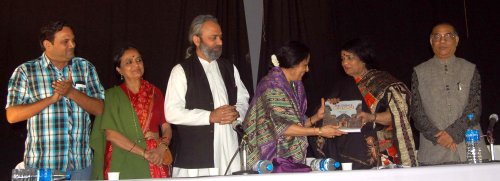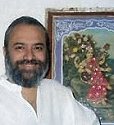
|   |

|   |
Impressions on International Odissi Festival - Ashish Mohan Khokar e-mail: khokar1960@gmail.com Photos: Arabinda Mahapatra December 31, 2011 The biggest ever collection of Orissi dancers and divas, gurus and gunijans, critics and connoisseurs took place in Bhubaneswar from 23rd – 30th Dec. The idea of this event has been mentored and executed by Pratap Das, an Orissi devotee, based in Washington D.C, almost ten years ago and now it has grown from a small acorn to a handsome tree. This happened due to providential and timely help from a distinguished fellow Oriya, former Foreign Secretary (who was later our Ambassador to the USA) Lalit Mansingh, who is also the son of litterateur Mayadhar Mansinha and was married to Sonal Mansingh, the Padma Vibhushan icon of Orissi, who released the latest tome on Orissi dance – The Dance Orissi - by Mohan Khokar and yours truly, at the festival’s inaugural seminar.  "The Dance Orissi" launched at the International Odissi Festival inaugural seminar L-R: Poet Kedar Mishra, Kumkum Lal, Ashish Mohan Khokar, Sonal Mansingh, Minati Mishra and S Pani  That over, the senior-most active Orissi diva today, Sonal Mansingh took to stage and showed Orissi which is a reference point, as this artiste has done much to popularize and take Orissi far. Sonal’s strong persona is such that her dance is electrified by a unique energy and expectation. Ileana Citaristi coming soon after such an iconic diva like Sonal Mansingh, acquitted well in her abhinaya piece on the Navarasas. In this festival, Ileana proved she is a good choreographer, as was seen in her group production symbolizing diya-s, in which the beauty of small group work could be seen. Sujata Mohapatra’s ‘Varsa’ was like a scene from Panchavati, so soaked in rain it was! One could almost sense faraway rain and the overall effect was mesmerizing, with blue mood lighting and excellent musical accompaniment, headed by her husband Ratikant Mohapatra himself on the percussion. Ratikant is a musician first and last. That is his natural domain and talent.
Ramli Ibrahim remained visible on all three days, morning and evening shows, making it bit of an over projection of one artiste or group. Either it was his students, his Sutra group or he himself. Fortunately, all his students, group and his own dance, are first rate. Here is one dancer that has kept Orissi in pristine form and done his gurus proud. He shows the strength and beauty of his guru’s style, full of masculinity and lasya at the same time. Impeccable aharya and aesthetics, perfectly trained bodies are hallmark of Sutra and Ramli and kudos to that alone, because all through the festival one saw baby elephants on stage! Most dancers are over-weight and have no business to be on stage. Some were totally unconcerned and danced with no reservation, giving hope to obese dancers, who may shy away from being on stage! 10am to 10 pm: Yes, our eyes smarted from 12 hours of non-stop Orissi watching. Over 100 dancers a day, in group or solo versions and while most have something to write home about, a few that stood out are Pallavi Das, a clear star material and a naturally gifted lass from USA. She is like what Sanjukta Panigrahi must have been when she was younger. Perfection of technique and a ready, easy abhinaya rich face, make her dance, sparkling. The festival showed one interesting aspect very strongly: while each guru has trained their ward well, and some perform excellently too, it is only one or two in a whole gang of over 600 dancers that showed spark. Pallavi is one such. Niharika Mohanty is another, though of much quieter quality. Her dance had a solidity and suppleness, a rare twin quality. The third was Shashwati Garai Ghosh, a Yamini look alike in Sharmila Biswas’ duet presentation.
Rahul Acharya showed why he rules many a heart with impeccable delivery. There is some lip movement he can’t seem to control but the overall effect of his dance art is like a finely cut diamond. Again Deba Prasad style won hands down on Day 3. Gajendra Panda’s students and group showed how this maverick trains well and despite many speed breakers, he plods on. Pankaj Charan Das family presentation was least represented and not so well by what little one saw in candle holding youngsters. Ritha Devi was in town, and despite a bad leg, could have showcased an abhinaya item. Nrityagram too was conspicuous by its absence. Kumkum Lal’s inwardly bent postures did nothing to augment her rendition or reputation as a senior artiste. Kabita Dwibedi, Sharmila Mukerjee and Jyoti Shrivastav from Delhi shared their Orissi. Sonali Mishra is a cut above many and Nabha Kishore remained an original.
Many, many participating foreigners showed how well they have learnt and imbibed the style. Michelle Chang from China and Douglas from USA (Ratna Roy’s student) showed fine mastery and superb delivery. He looks 14, although he is 40! Ratna Roy’s screechy voice is not for compering at all, as it’s very brittle like a small child’s, until she showed up on stage and we realised it was a grown up! The scholar in her emerged when she stepped in to be seminar moderator on Day Two. Often, loud music volumes too did not do much to salvage the dance presentations. In live music, each member of the orchestra party wants his to be the loudest sound. Organisers should give standing instructions to technicians to balance levels, not fall prey to individual demands. Pratap Das was an understated organizer and deserves much credit for serving dance. He remained amiable all through. The sheer scale and size of this “largest ever gathering of Orissi dancers” cannot be equaled, so all kudos to Ashok Tripathy, the affable and active Tourism and Culture Secretary and Pratap Das, the doers. Niranjan Tripathy and other devotees from USA also did lots to help run the festival well. The seminars threw up interesting aspects and concerns and while there was not much debate, there was surely some sharing. Day One seminar on aesthetics had Sonal Mansingh ably conducting the proceedings with veteran Minati Mishra giving life-felt account of aesthetics. Sonal seconded yours truly’s opinion that in big group works Orissi was getting Bharatanatyamised. The lyricism was missing and angularity and speed were taking forefront. Dr. S Pani, the well dressed scholar-bureaucrat gave a well addressed presentation using Geeta Govinda, his lifetime research work, as base and presented aspects of aesthetic in shastric contexts. Poet Kedar Mishra spoke in Oriya and shared how the form has to be culture specific.
Seminar on Day Two on ‘Challenges Orissi is likely to face in 21st Century,’ platformed points as divergent as how difficult it is to teach in an alien setting to what technology can help with (Dave) and how to negotiate a path between tradition and modernity. Leela Venkataraman remained the most focused speaker. Kabita Dwibedi proved to be a most natural speaker when she spoke of issues that concerned a dancer on ground like sponsorship and support. The festival also showed a sad state of affairs when local critics felt marginalized (“we are not even offered lunch or water,” one commented) and others felt that mofussil Odisha should also get to see such festivals. As Odisha has few dance specific writers or critics in English, it is incumbent on those visiting to share expertise and experience. Dance should bind; dance should give joy. New generation teachers (can’t call them gurus as they lack most qualities of being a guru), critics and promoters should rise above pettiness and serve larger goals that will help serve the legacy of their forefathers and real giants. If one were to rate the most original, impeccable Orissi piece in three days of the festival one witnessed, it was clearly Sharmila Biswas'. There was tradition meeting beauty of form, clarity of structure and thoughtful depiction that was aesthetically high and artistically meritorious. As Leela Venkataraman and I boarded our flights to south, we could only say, “Jai Jagannath!”  Ashish Mohan Khokar learnt Kathak, Bharatanatyam, western ballet and
Orissi before taking to arts administration. He served the govt., in
many cultural capacities, including the Delhi State Academy for Arts
(1984-85); chief coordinator Festivals of India in Sweden (1986-87);
Festival of India in France, Germany and China (1985-90). He was
Director of INTACH, under PM Rajiv Gandhi’s Chairmanship. He served the
Times of India as Dance Critic in Delhi from 1990-2000 and Bangalore
2000-3. Since then, he edits and publishes India’s only yearbook on
dance – attendance - and is Curator of the Mohan Khokar Dance
Collection. He has served dance for over 25 years as a reputed
critic-historian. He has written over 35 books on Indian arts and
culture; is on many boards and committees serving dance (DD, INTACH,
IIC, BSM, ICCR, UNESCO-DC). He Chairs the Dance
History Society of India and holds special dance DISCourses. Ashish Mohan Khokar learnt Kathak, Bharatanatyam, western ballet and
Orissi before taking to arts administration. He served the govt., in
many cultural capacities, including the Delhi State Academy for Arts
(1984-85); chief coordinator Festivals of India in Sweden (1986-87);
Festival of India in France, Germany and China (1985-90). He was
Director of INTACH, under PM Rajiv Gandhi’s Chairmanship. He served the
Times of India as Dance Critic in Delhi from 1990-2000 and Bangalore
2000-3. Since then, he edits and publishes India’s only yearbook on
dance – attendance - and is Curator of the Mohan Khokar Dance
Collection. He has served dance for over 25 years as a reputed
critic-historian. He has written over 35 books on Indian arts and
culture; is on many boards and committees serving dance (DD, INTACH,
IIC, BSM, ICCR, UNESCO-DC). He Chairs the Dance
History Society of India and holds special dance DISCourses. Details: www.attendance-india.com |